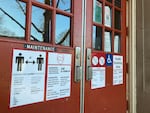
Portland Public Schools have been closed to in-person learning since March 2020. Signs on the front doors at Sabin Elementary School lay out COVID-19 health procedures for the anticipated return of students.
Rob Manning / OPB
Two years ago, nearly 19% of Portland Public Schools students were missing school so consistently they were labeled “chronically absent” by the Oregon Department of Education. That was pretty close to the state average.
Now, with nearly all of the district’s roughly 49,000 students learning online, the share of students missing at least one day every other school week has risen to 22% this year, according to new data PPS shared this week at a meeting with the Portland Association of Teachers.
That number, while higher than a normal in-person school year, actually understates the impact that online learning is having on some of the district’s historically underserved students, particularly Black and Latino students.
The most recent data snapshot shared this week shows significantly higher rates of chronic absence among Latino students this year. Over 34% of Latino students are missing at least one day every other week, up from 27% in the 2018-19 school year. But most of the Latino students missing a significant amount of school this year are well below the bar for “chronic absence.” Nearly 22% of Latino students in PPS qualify as “severe,” meaning they miss one day every week, not just a day every other week.
Oregon’s largest district is having an even harder time staying connected to its Black student population.
The new PPS data show Black students have a 41.5% rate of chronic absence, fully 10 percentage points higher than the rates two years ago of 31.4%. And as with Latino students, a significant portion of those students are missing a “severe” amount of school. The new PPS data shows more than a quarter of Black students, 27%, qualify for that “severe” category, for missing at least one day of school per week, on average.
Portland Public Schools chief of schools Shawn Bird shared the data with the Portland Association of Teachers as part of ongoing discussions the district is having with the union this winter.
“The reasons for chronic absenteeism, they are many,” Bird told the union. “Could be technology issues, that they could have to care for a sibling. So that doesn’t tell us why, it just tells us the what.”
The numbers were highlighted at a Friday press conference from parent advocacy group, ED300, which has been leaning on officials at the state and local levels to reopen classrooms as quickly as possible.
“We’ve got a lot of students not able to attend school, or not willing to attend school, and this is just not acceptable,” said Ed Happel, with ED300.
The district also shared data, noted by the parents’ group, that the proportion of students sliding into a “chronic” or “severe” absence situation is growing. The number of students falling into those problematic categories has nearly doubled since the school year began, from 6,875 to 13,155. At the same time, students considered “good” attenders, meaning they’re in class at least 95% of the time, has plummeted by 9,045 students from Sept. 2020 to Feb. 2021.
“Every month, it gets a little bit worse,” Bird said.
PPS administrators are preparing to move elementary students toward a “hybrid” learning model by mid-April, one in which students would spend part of the school week learning in-person. The district has a survey out to parents of elementary students and initial responses have found support for moving in that direction. By a two-to-one margin, parents who responded said they’d prefer “hybrid” instruction, rather than continuing all online.
